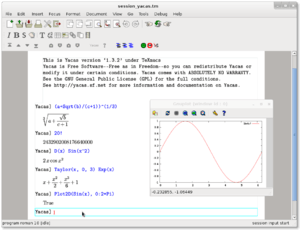GNU TeXmacs
 | |
|
TeXmacs | |
| Developer(s) | GNU Project |
|---|---|
| Stable release | 1.99.5 (July 7, 2016) [±] |
| Operating system | Linux, Windows, Mac OS X, Unix-like[1] |
| Type | Word processor |
| License | GNU GPLv3[2] |
| Website |
www |
GNU TeXmacs is a free scientific word processor and typesetting component of the GNU Project. It was inspired by TeX and GNU Emacs, though it shares no code with those programs. TeXmacs does use TeX fonts.[3] It is written and maintained by Joris van der Hoeven. The program produces structured documents with a WYSIWYW user interface. New document styles can be created by the user. The editor provides high-quality typesetting algorithms and TeX fonts for publishing professional looking documents.
Features
TeXmacs can handle mathematical formulas and is used as a front-end to a number of computer algebra systems such as Maxima and SageMath. TeXmacs also supports a Scheme extension language called Guile for customizing the program and writing extensions.

Like many WYSIWYG editors (such as Microsoft Word), authors manipulate a document on screen which should print to a similar looking paper copy. The goal of TeXmacs is to provide a WYSIWYG editor that nevertheless makes it possible to write correctly structured documents with aesthetically pleasing typesetting results. TeXmacs is not a front-end to LaTeX[4] but TeXmacs documents can be converted to either TeX or LaTeX. LaTeX also can be imported (to some extent), and both import to HTML, Scheme, "Verbatim", and XML and export to them is provided.[5] There is a converter for MathML as well, and TeXmacs can output PDF and PostScript for printing.[6]
TeXmacs currently runs on most Unix-based architectures including Linux, FreeBSD, Cygwin and Mac OS X. Along with the Cygwin version, a native beta port is available for Microsoft Windows.
TeXmacs also features a presentation mode and there are plans to evolve towards a complete scientific office suite with spreadsheet capacities and a technical drawing editor.
Mathematical typography
TeXmacs facilitates the inputting of mathematical formulas by mapping sequences of keyboard symbols to symbols. For example, the symbol can be input by typing =>.
Some symbols have no such representation ( for instance). These can be input with tab key. This keyboard-based entry differs from other formulae editors, that tend to provide point-an-click menus for this task. [7]
Batch processing
It is possible to use TeXmacs as a batch processor (which is LaTeX's usual operation mode), using X virtual framebuffer to avoid opening unwanted windows while processing. For example, the command
xvfb-run texmacs --convert article.tm article.pdf --quit
generates a PDF file "article.pdf" from a TeXmacs document "article.tm".
Supported back ends

TeXmacs has back-ends supporting many technologies.
Programming languages: CLISP, CMUCL, Python, QCL, R, Shell
Computer algebra systems: Axiom, Giac, Macaulay 2, Mathematica, Maxima, Mupad, PARI/GP, Reduce, SageMath, Yacas
Numeric matrix systems: GNU Octave, Matlab, Scilab
Plotting packages: gnuplot, Graphviz, XYpic, Mathemagix
Other: DraTeX, Eukleides, GTybalt, Lush, Juris-M or Zotero (research citation references and bibliography manager, better than BibTeX.)
See also
References
- ↑ "Downloading and installing TeXmacs (FSF GNU project)". Texmacs.org. Retrieved 2010-05-29.
- ↑ "The GNU General Public License". Texmacs.org. Retrieved 2010-12-27.
- ↑ Frequently asked questions (FSF GNU project)
- ↑ van der Hoeven, Joris (2006-08-21). "GNU TeXmacs: a scientific editing platform" (PDF). www.texmacs.org. pp. 7f. Retrieved 2016-01-16.
Since TeXmacs is not a LaTeX front-end, it follows that we can only ensure correct conversions for a (quite large) sublanguage of LaTeX.
- ↑ van der Hoeven, Joris; Seidl, Andreas (2011). "Frequently asked questions". www.texmacs.org. Retrieved 2016-01-16.
- ↑ van der Hoeven, Joris (2012). "Welcome to GNU TeXmacs". www.texmacs.org. Retrieved 2016-01-16.
- ↑ See the user manual : « Typing mathematical symbols ».

